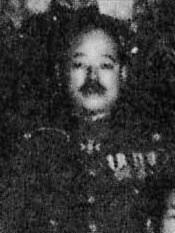Event: Battle of Kranji
Time: 9th February ~ 10th February 1942
Factions involved: Allied Forces, Japanese Army
Result: Japanese Victory (Though huge losses were incurred to the Japanese)
Background Information
 |
| Major General Takuma Nishimura |
The terrain around Kranji was primarily mangrove swamps and tropical forest intersected by streams and inlets. The shoreline between the Kranji River and the Causeway, nearly four kilometers long, was defended by the Australian 27th Brigade which consisted of three battalions and was led by Australian Brigadier Duncan Maxwell. The British forces were also supported by the Dalforce, a local Chinese militia consisting of Communists, Nationalist supporters and other volunteers.
400 Imperial Guards landed and took Pulau Ubin, encountering minimal resistance. Those 400 Imperial Guards were also the Japanese that were going to attack the Allied forces at Kranji, led by Major General Takuma Nishimura.
Battle
9th February 1942 -- Japanese Landings
Two divisions of the Japanese Twenty Fifth Army, led by Lieutenant General Tomoyuki Yamashita, landed on the northwestern coast of Singapore (Sarimbun area). The primary objective of their landing at Kranji was to capture Kranji village; this would let them repair the demolished Causeway in order to facilitate the easy transport of reinforcements and supplies to Singapore for the vanguard force.
Once the leading wave of Japanese was ashore, the massed Japanese artillery switched their fire to the defensive positions at Kranji, destroying Allied telegraph and telephone communications and breaking the communications between the Allied front line and the Allied HQ.
At 8:30PM that night, the Japanese Imperial Guards Division began crossing from Johor in special armoured landing-crafts, collapsible boats and by swimming.
10th February 1942 -- Heavy losses (Japanese)
In the early hours of 10th February, Japanese forces moved up the Kranji River, advance landing parties from the 4th Regiment of the Imperial Guards finding themselves under heavy fire from Australian machine gunners and motars. They were also surrounded by oil slicks due to the emptying of Woodlands oil depot, to prevent the oil depot from being captured. The oil was soon set alight by Allied small arms fire, burning many Japanese soldiers alive (and killing them.)
The heavy losses suffered by the Japanese prompted Nishimura to request permission to abandon the landing operation. However, Yamashita denied the request.
Maxwell, who had limited communications with his division HQ, was concerned that his force would be cut off by fierce and chaotic fighting at Sarimbun and Jurong. Maxwell's force consequently withdrew from the seafront. This allowed the Japanese to land and take control of Kranji village. They also captured Woodlands and began repairing the causeway, encountering no resistance from the Allies.
Japanese light tanks, which had good buoyancy) were towed across the straits to Lim Chu Kang Road. When they joined the battle at dusk, the reinforced Japanese troops (with the newly added tanks) became too strong for the Australian troops, causing them to flee to the hills of Bukit Panjang.
Bukit Timah Village was then captured on the 11th of February (the next day).
Jurong-Kranji Defence Line
The defence line was drawn by Lieutenant-General Arthur Percival. The defence line is a perimeter encompassing the Kallang aerodrome, MacRitchie and Peirce reservoirs and the Bukit Timah supply depot area. The Line was defended by the 12th, 15th and 44th Indian Infantry Brigade along with the reinforced 22nd Australian Brigade. A secret instruction to protect this area (the place within the Defence Line) was issued by Percival to his generals.
However, Percival's secret orders to withdraw to the Line "only if necessary" were misunderstood by Maxwell, who took this as an order for immediate withdrawal. As a result, the 12th and 44th Indian Infantry Brigades and the 22nd Australian Brigade reinforced their withdrawal from Sarimbun beach, abandoning the Line.
Aftermath
By 11th February, the Line was left undefended, which allowed the Japanese forces to sweep through the Line to attack Bukit Timah. Despite the opposition from the Dalforce fighters, the Dalforce fighters were too weak to resist the Japanese for they had poor training and lack of equipment. A further blow was delivered when the 27th Australian Brigade withdrew southwards.
As a result, the Japanese were able to establish a stronghold in the northern Woodlands area and secured a relatively easy passage into Singapore.
By 12 February, the Imperial Guards had captured the reservoirs and Nee Soon village. The defending troops, by this time, were badly shaken. Thousands of exhausted and frightened stragglers left the fighting to seek shelter in large buildings. On the same night, British forces in the east of the island had begun to withdraw towards the city.
On 13 February, the Japanese 5th Division continued its advance and reached Adam and Farrer Roads to capture the Sime Road Camp. Yamashita moved his HQ forward to the bomb-damaged Ford Factory in Bukit Timah. Heading southwards, the Japanese 18th Division advanced into Pasir Panjang, where the last major battle of Singapore would be fought with the Malay Regiments at Bukit Chandu (a battle which the Allies lost, and subsequently, lost Singapore to the Japanese.)
References
Sources:
(1942, 1 February). Aust_AT_gun_Singapore_(012449).jpg. Retrieved June 27, 2013,
from http://upload.wikimedia.org/wikipedia/commons/8/8b/Aust_AT_gun_Singapore_%28012449%29.jpg
(2013, 17 March). Battle of Kranji. Retrieved June 27, 2013, from http://en.wikipedia.org/wiki/Battle_of_Kranji
(Date Created/Modified Unknown) Nishimura_Takuma.jpg. Retrieved June 27, 2013, from http://upload.wikimedia.org/wikipedia/commons/8/89/Nishimura_Takuma.jpg
(1942, 1 February). Aust_AT_gun_Singapore_(012449).jpg. Retrieved June 27, 2013,
from http://upload.wikimedia.org/wikipedia/commons/8/8b/Aust_AT_gun_Singapore_%28012449%29.jpg
(2013, 17 March). Battle of Kranji. Retrieved June 27, 2013, from http://en.wikipedia.org/wiki/Battle_of_Kranji
(Date Created/Modified Unknown) Nishimura_Takuma.jpg. Retrieved June 27, 2013, from http://upload.wikimedia.org/wikipedia/commons/8/89/Nishimura_Takuma.jpg
(2013, 12 June). Imperial Guard (Japan). Retrieved June 27, 2013, from http://en.wikipedia.org/wiki/Imperial_Guard_%28Japan%29
(2011, 16 November). World War 2 Battle of Kranji. Retrieved June 28, 2013, from http://nhbww2.blogspot.sg/2011/11/world-war-2-battle-of-kranji.html

.jpg)
No comments:
Post a Comment